13 books about Head-driven phrase structure grammar
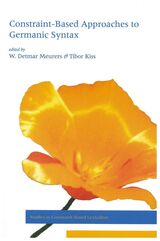
Constraint-Based Approaches to Germanic Syntax
Edited by W. Detmar Meurers and Tibor Kiss
CSLI, 2001
A wealth of research has been conducted on the various linguistic phenomena found in Germanic languages. But these studies were restricted by their use of only one theoretical perspective to analyze one particular language. Inspired by the need to expand the research base of Germanic languages while broadening the empirical coverage of constraint-based linguistic approaches, a handful of researchers are employing various constraint-based theoretical perspectives to study multiple Germanic languages.
This volume begins with an introduction to the recent research performed on Germanic syntax using constraint-based frameworks. It then goes on to investigate the linguistic phenomena found in the grammar of the German and Danish languages. Using such approaches as Lexical-Functional Grammar and Head-Driven Phrase Structure Grammar, contributors shed a different light on theoretical issues addressed by past studies, including semi-free word order, partial front phenomena, and complex predicate formation. While alternative approaches have assumed that meaning (semantics) is dependent on form (syntax), various analyses presented in this volume explore the idea that both form and meaning are equally constitutive for grammatical descriptions.
This volume begins with an introduction to the recent research performed on Germanic syntax using constraint-based frameworks. It then goes on to investigate the linguistic phenomena found in the grammar of the German and Danish languages. Using such approaches as Lexical-Functional Grammar and Head-Driven Phrase Structure Grammar, contributors shed a different light on theoretical issues addressed by past studies, including semi-free word order, partial front phenomena, and complex predicate formation. While alternative approaches have assumed that meaning (semantics) is dependent on form (syntax), various analyses presented in this volume explore the idea that both form and meaning are equally constitutive for grammatical descriptions.
[more]
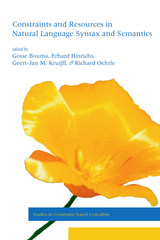
Constraints and Resources in Natural Language Syntax and Semantics
Edited by Gosse Bouma, Erhard Hinrichs, Geert-Jan M. Kruijff, and Richard Oehrle
CSLI, 1999
This collection draws together recent work on constraint-based and resource-sensitive approaches to the grammar of natural languages. Some of the issues addressed are: extraction phenomena in a range of languages, the syntax of nominal phrases, the role of argument structure, defining the interface between syntax and morphology and between semantics and prosody, quantifier scope, remnant movement, construction grammar, and formal and computational aspects of grammar formalisms. This volume brings together the leading linguists, logicians, and computer scientists working on Head-driven Phrase Structure Grammar and Categorial Grammar. Derived from two recent conferences on Formal Grammar and Head-driven Phrase Structure Grammar in Aix (1997) and Saarbrücken (1998), this volume represents the most current work in these frameworks.
[more]
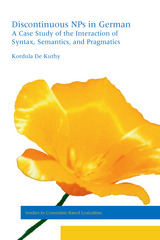
Discontinuous NPs in German
A Case Study of the Interaction of Syntax, Semantics, and Pragmatics
Kordula De Kuthy
CSLI, 2002
This book investigates the occurrence of discontinuous noun phrases, arguing that many of the factors that previous literature has tried to explain in terms of syntactic restrictions on movements are in fact derivable from discourse factors. De Kuthy’s HPSG and information-structure analyses provide an exemplary argument for rethinking the division of labor between syntax and a theory of discourse.
[more]
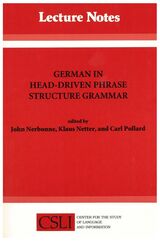
German in Head-Driven Phrase Structure Grammar
Edited by John Nerbonne, Carl Pollard, and Klaus Netter
CSLI, 1993
These essays apply the syntactic theory of Carl Pollard and Ivan Sag—Head-driven Phrase Structure Grammar (HPSG)—to a formal study and analysis of German grammar. A wide variety of fundamental and well-known phenomena in German grammar are addressed, including the German passive and impersonal passive, various Mittelfeld and Vorfeld word-order phenomena (including auxiliary stacking and the distribution of adjuncts), and the structure of phrasal constituents. Linguistic issues include the treatment of idioms, word-order variation and phrase structure constituency, subcategorization, complementation, argument structure, case assignment, lexical rules, and syntactic ambiguity.
The theoretical background for these essays can be found in Information-Based Syntax and Semantics and Head-Driven Phrase Structure Grammar, both by Pollard and Sag and both available from the University of Chicago Press.
The theoretical background for these essays can be found in Information-Based Syntax and Semantics and Head-Driven Phrase Structure Grammar, both by Pollard and Sag and both available from the University of Chicago Press.
[more]
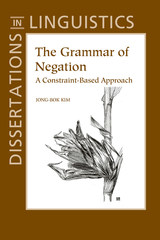
The Grammar of Negation
Jong-Bok Kim
CSLI, 2000
This book addresses three fundamental questions in the study of negation: What are the main ways of expressing sentential negation? What are the distributional properties of lexically-encoded negative elements? And, what implications do the answers to these two questions have for the theory of grammar? In answering these questions, Jong-Bok Kim investigates various aspects of negation in Korean, English, French and Italian. Addressing both empirical and theoretical issues relating to negation in these languages, he develops a nonderivational, lexicalist analysis within the constraint-based framework of Head-driven Phrase Structure Grammar. This work demonstrates that a constraint-based approach can capture the distributional possibilities of negative elements and explain related phenomena simply through their lexical properties and the interaction of the elementary morphosyntactic and valence properties of syntactic heads. The resulting constraint-based theory allows a conservative division of labor between morphology and syntax.
[more]
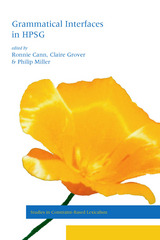
Grammatical Interfaces in HPSG
Edited by Ronnie Cann, Claire Grover, and Philip H. Miller
CSLI, 2001
This collection of recent work in Head-Driven Phrase Structure Grammar focuses on interfaces between different grammatical components; its fifteen papers explore interface phenomena such as auxiliary contraction in English, analysis of illocutionary force in HPSG, syntactic and semantic aspects of Korean relative clause formation, negation in Welsh, and several others.
[more]
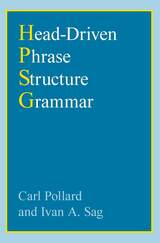
Head-Driven Phrase Structure Grammar
Carl Pollard and Ivan A. Sag
University of Chicago Press, 1994
This book presents the most complete exposition of the theory of head-driven phrase structure grammar (HPSG), introduced in the authors' Information-Based Syntax and Semantics. HPSG provides an integration of key ideas from the various disciplines of cognitive science, drawing on results from diverse approaches to syntactic theory, situation semantics, data type theory, and knowledge representation. The result is a conception of grammar as a set of declarative and order-independent constraints, a conception well suited to modelling human language processing.
This self-contained volume demonstrates the applicability of the HPSG approach to a wide range of empirical problems, including a number which have occupied center-stage within syntactic theory for well over twenty years: the control of "understood" subjects, long-distance dependencies conventionally treated in terms of wh-movement, and syntactic constraints on the relationship between various kinds of pronouns and their antecedents. The authors make clear how their approach compares with and improves upon approaches undertaken in other frameworks, including in particular the government-binding theory of Noam Chomsky.
This self-contained volume demonstrates the applicability of the HPSG approach to a wide range of empirical problems, including a number which have occupied center-stage within syntactic theory for well over twenty years: the control of "understood" subjects, long-distance dependencies conventionally treated in terms of wh-movement, and syntactic constraints on the relationship between various kinds of pronouns and their antecedents. The authors make clear how their approach compares with and improves upon approaches undertaken in other frameworks, including in particular the government-binding theory of Noam Chomsky.
[more]
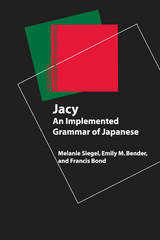
Jacy
An Implemented Grammar of Japanese
Melanie Siegel, Emily M. Bender, and Francis Bond
CSLI, 2017
This book describes the fundamentals of Jacy, an implementation of a Japanese head-driven phrase structure grammar with many useful linguistic implications. Jacy presents sound information about the Japanese language (syntax, semantics, and pragmatics) based on implementation and tested on large quantities of data. As the grammar development was done in a multilingual environment, Jacy also showcases both multilingual concepts and differences among the languages and demonstrates the usefulness of semantic analysis in language technology applications.
[more]
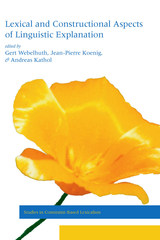
Lexical and Constructional Aspects of Linguistic Explanation
Edited by Gert Webelhuth, Jean-Pierre Koenig, and Andreas Kathol
CSLI, 1999
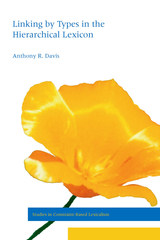
Linking by Types in the Hierarchical Lexicon
Anthony R. Davis
CSLI, 2001
Actions are described by verbs whose subjects, objects, and other complements refer to various participants in those actions. What linguistic principles determine which participants are referred to by each component of a verb?
Many previous approaches to this problem have employed a set of thematic roles, such as agent and patient, to classify varieties of participants. The alternative developed here fits within the framework of Head-Driven Phrase Structure Grammar while utilizing typed feature structures, certain basic features of verb meaning, a hierarchical classification of verb meanings, and constraints from more general to more specific word classes. Relying on no special mechanisms or components of grammar, this book is unique in its ability to account for the observed range of verb types in human languages with a simple yet widely applicable set of principles.
Many previous approaches to this problem have employed a set of thematic roles, such as agent and patient, to classify varieties of participants. The alternative developed here fits within the framework of Head-Driven Phrase Structure Grammar while utilizing typed feature structures, certain basic features of verb meaning, a hierarchical classification of verb meanings, and constraints from more general to more specific word classes. Relying on no special mechanisms or components of grammar, this book is unique in its ability to account for the observed range of verb types in human languages with a simple yet widely applicable set of principles.
[more]

Romance in HPSG
Edited by Sergio Balari and Luca Dini
CSLI, 1997
This book describes several aspects of syntax and semantics of romance languages assuming the point of view of a constraint-based, non-transformational linguistic theory, i.e. Head-driven Phrase Structure Grammar (HPSG). Besides the widening of the empirical coverage of HPSG the theory, its main significance consists in a refinement of the theory itself, on the basis of data from romance languages. It contains essays discussing phenomena from Catalan, French, Italian and Spanish.
[more]

Sign-Based Construction Grammar
Edited by Hans C. Boas and Ivan A. Sag
CSLI, 2012
This book offers a long-awaited unified and precise treatise on construction-based grammar. The approach to grammar presented here is the union of Berkeley Construction Grammar, as represented by the early work of Charles J. Fillmore and Paul Kay, with construction HPSG as pioneered by Ivan Sag, Carl Pollard, and others. The presentation of this theory in a detailed chapter by Sag presents the full outlines of a new approach to grammar. It reflects the confluence of two separate, although converging, traditions, and constitutes a novel synthesis.
[more]
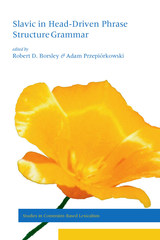
Slavic in Head-Driven Phrase Structure Grammar
Edited by Robert D. Borsley and Adam Przepiórkowski
CSLI, 1999
This book is the first collection of papers on Slavic language within a formal non-transformational linguistic formalism. The articles presented here are concerned with all components of grammar, from semantics, through syntax and morphology, to phonology. In particular, the following phenomena are given HPSG analyses: syntax and semantics of negation, anaphor binding, syntax and morphology of auxiliaries, {\em wh}-extraction, syntax and morphology of case assignment, diathesis and voice, complement vs. adjunct distinction, and syntactic haplology. The main languages dealt with are Polish and Serbo-Croatian, but Russian, Czech and Bulgarian are also represented.
[more]
READERS
Browse our collection.
PUBLISHERS
See BiblioVault's publisher services.
STUDENT SERVICES
Files for college accessibility offices.
UChicago Accessibility Resources
home | accessibility | search | about | contact us
BiblioVault ® 2001 - 2024
The University of Chicago Press









